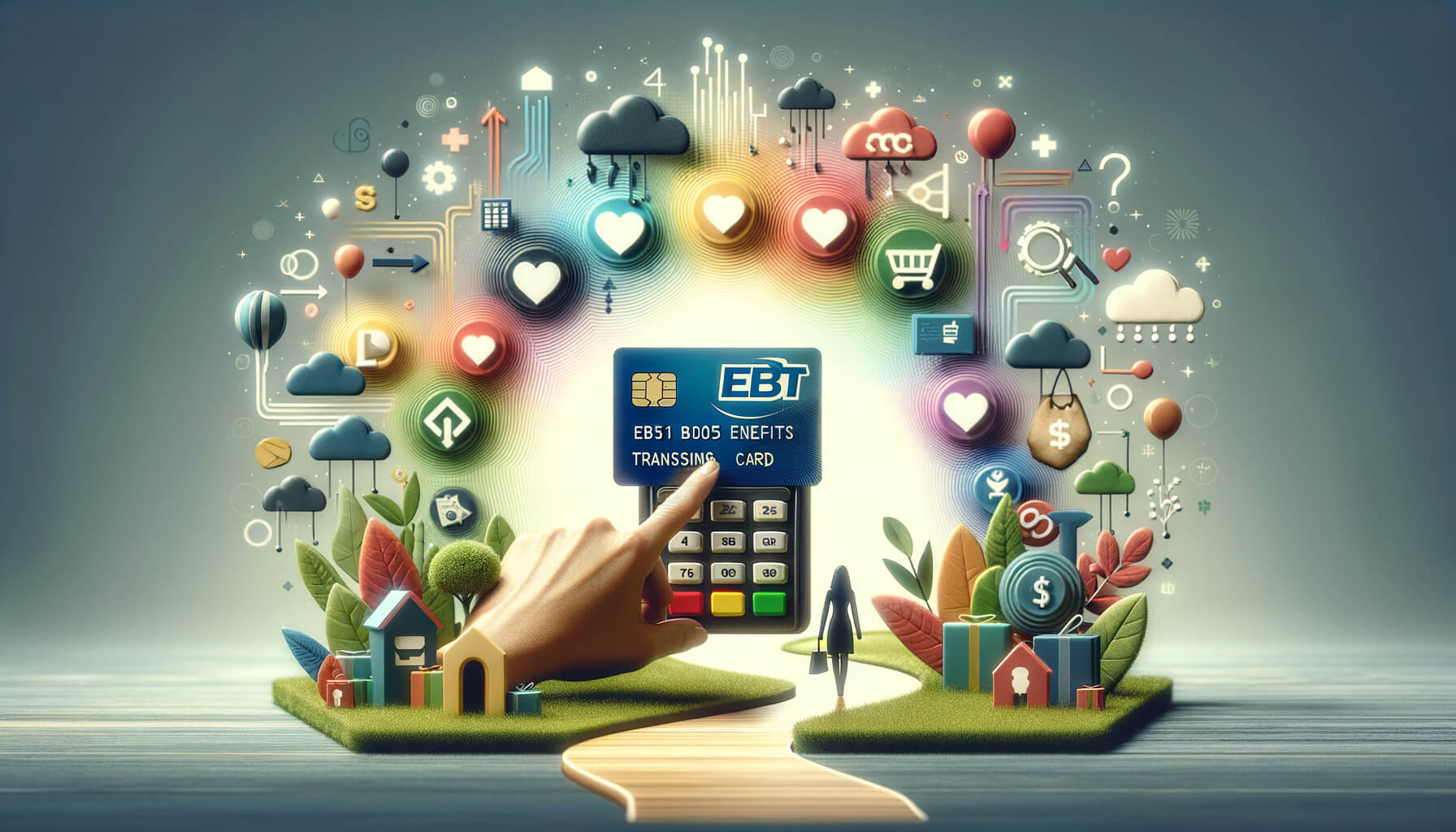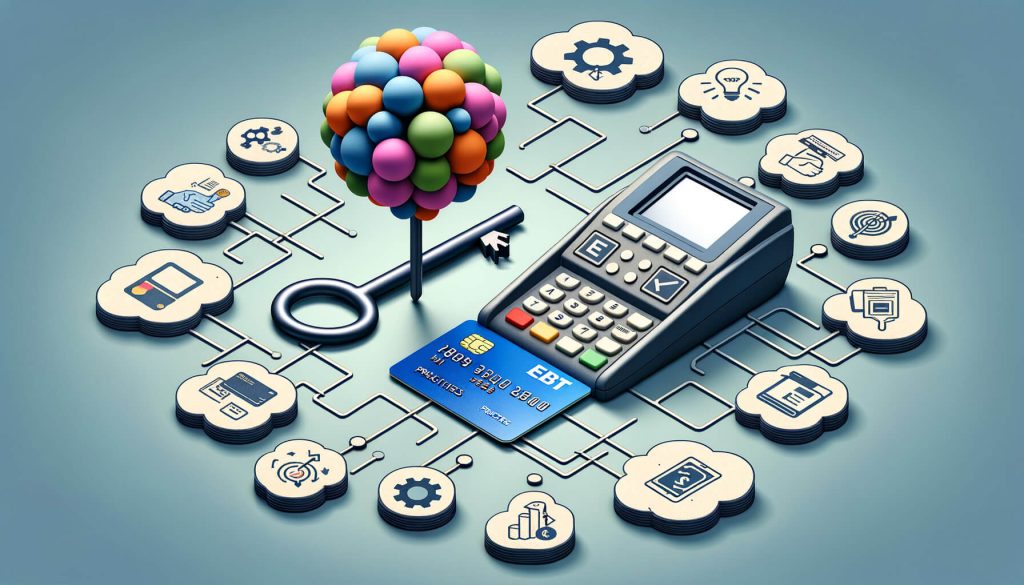
By Ethan Brooks November 4, 2024
In today’s digital age, payment processing has become an integral part of any business operation. Electronic Benefit Transfer (EBT) payment processing is a system that allows eligible individuals to access government benefits, such as food stamps or cash assistance, through a debit card. While EBT payment processing is primarily associated with government assistance programs, it can also be used by merchants to increase customer loyalty and improve overall customer experience.
EBT payment processing offers numerous benefits for both customers and merchants. For customers, it provides a convenient and secure way to access their benefits, eliminating the need for paper vouchers or checks. Additionally, EBT payment processing allows customers to make purchases at authorized retailers, including grocery stores, farmers markets, and even online platforms. This flexibility enhances the overall shopping experience for customers, leading to increased satisfaction and loyalty.
For merchants, implementing EBT payment processing can lead to a range of advantages. Firstly, it expands the customer base by attracting individuals who rely on government benefits for their daily needs. This segment of the population represents a significant market opportunity, as government assistance programs serve millions of people across the country. By accepting EBT payments, merchants can tap into this market and increase their customer base.
Furthermore, EBT payment processing can streamline the payment process, reducing the time and effort required for both customers and merchants. Traditional methods of accepting government benefits, such as paper vouchers or checks, can be time-consuming and prone to errors. EBT payment processing eliminates these inefficiencies, allowing for faster and more accurate transactions. This not only improves the overall shopping experience for customers but also enhances operational efficiency for merchants.
Overall, EBT payment processing plays a crucial role in customer loyalty by providing a convenient and secure payment method for individuals receiving government benefits. By implementing this system, merchants can attract a new customer segment, streamline their payment processes, and ultimately increase customer satisfaction and loyalty.
How EBT Payment Processing Works: A Step-by-Step Guide

To understand the benefits of EBT payment processing, it is essential to grasp how the system works. EBT payment processing involves several steps, from the initial issuance of benefits to the final transaction at the point of sale. Here is a step-by-step guide to the EBT payment process:
- Eligibility Determination: Individuals must first apply for and be approved for government assistance programs, such as the Supplemental Nutrition Assistance Program (SNAP) or Temporary Assistance for Needy Families (TANF). Eligibility is determined based on income, household size, and other factors.
- Benefit Issuance: Once approved, eligible individuals receive an EBT card, similar to a debit card, which is loaded with their benefits. The card is typically issued by the state or federal agency responsible for administering the assistance program.
- Card Activation: Before using the EBT card, individuals must activate it by calling a toll-free number or visiting a designated website. This step ensures that the card is ready for use and helps prevent unauthorized access to benefits.
- PIN Selection: After activation, individuals are prompted to select a Personal Identification Number (PIN) for their EBT card. The PIN serves as a security measure and must be entered at the point of sale to authorize transactions.
- Merchant Authorization: Retailers interested in accepting EBT payments must apply for authorization from the appropriate government agency. This process involves completing an application, providing necessary documentation, and undergoing a review to ensure compliance with program regulations.
- Transaction Processing: When a customer with an EBT card makes a purchase, they present the card to the cashier, who swipes or inserts it into a card reader. The customer then enters their PIN to authorize the transaction. The card reader communicates with the EBT payment processing system to verify the available balance and deduct the purchase amount.
- Payment Settlement: Once the transaction is authorized, the EBT payment processing system settles the payment by transferring the funds from the customer’s EBT account to the merchant’s designated account. This process typically occurs within a few business days.
By understanding the step-by-step process of EBT payment processing, merchants can effectively implement the system and provide a seamless experience for customers. The next section will explore the benefits of EBT payment processing for both customers and merchants in more detail.
Benefits of EBT Payment Processing for Customers

EBT payment processing offers several benefits for customers, making it a preferred payment method for individuals receiving government benefits. Here are some key advantages of EBT payment processing for customers:
- Convenience: EBT payment processing provides a convenient way for customers to access their benefits. Instead of relying on paper vouchers or checks, customers can simply use their EBT card, similar to a debit card, to make purchases. This eliminates the need to carry multiple forms of payment and reduces the risk of loss or theft.
- Flexibility: EBT payment processing allows customers to make purchases at a wide range of authorized retailers, including grocery stores, farmers markets, and even online platforms. This flexibility enables customers to choose where and how they want to shop, enhancing their overall shopping experience.
- Security: EBT payment processing offers enhanced security compared to traditional methods of accepting government benefits. With an EBT card, customers can protect their benefits with a PIN, ensuring that only authorized individuals can access their funds. This reduces the risk of fraud or unauthorized use of benefits.
- Real-Time Balance Information: EBT payment processing provides customers with real-time information about their benefit balance. By checking their balance before making a purchase, customers can ensure that they have sufficient funds to cover the transaction. This helps prevent declined transactions and allows customers to plan their purchases accordingly.
- Automatic Benefit Deposits: EBT payment processing eliminates the need for customers to manually deposit their benefits. Once approved, benefits are automatically deposited into the customer’s EBT account on a regular basis. This ensures a consistent and reliable source of funds for individuals relying on government assistance.
- Access to Discounts and Incentives: Some retailers offer discounts or incentives specifically for customers using EBT payment processing. These promotions can help customers stretch their benefits further and save money on essential purchases. By taking advantage of these offers, customers can maximize the value of their benefits.
- Privacy: EBT payment processing offers a level of privacy for customers, as transactions are processed electronically. Unlike paper vouchers or checks, which may require customers to disclose personal information, EBT payment processing allows for discreet and confidential transactions.
- Reduced Stigma: EBT payment processing helps reduce the stigma associated with government assistance programs. By using an EBT card, customers can make purchases discreetly, without drawing attention to their financial situation. This promotes dignity and inclusivity for individuals relying on government benefits.
- Enhanced Budgeting: EBT payment processing can assist customers in managing their finances more effectively. By providing real-time balance information and automatic benefit deposits, customers can better plan their purchases and allocate their funds accordingly. This promotes responsible spending and financial stability.
- Customer Support: EBT payment processing typically includes customer support services to assist individuals with any issues or questions they may have. This support can range from a toll-free helpline to online resources, ensuring that customers have access to the assistance they need.
By offering these benefits, EBT payment processing enhances the overall shopping experience for customers and promotes customer loyalty. The next section will explore the advantages of EBT payment processing for merchants.
Benefits of EBT Payment Processing for Merchants

Implementing EBT payment processing can bring numerous advantages for merchants, making it a valuable addition to their payment options. Here are some key benefits of EBT payment processing for merchants:
- Expanded Customer Base: By accepting EBT payments, merchants can tap into a new customer segment – individuals receiving government benefits. Government assistance programs, such as SNAP, serve millions of people across the country. By catering to this market, merchants can attract a larger customer base and increase their sales potential.
- Increased Sales: EBT payment processing can lead to increased sales for merchants. Customers relying on government benefits often have limited financial resources and prioritize essential purchases, such as groceries. By accepting EBT payments, merchants can capture a portion of this spending and boost their sales volume.
- Streamlined Payment Process: EBT payment processing simplifies the payment process for both customers and merchants. Traditional methods of accepting government benefits, such as paper vouchers or checks, can be time-consuming and prone to errors. EBT payment processing eliminates these inefficiencies, allowing for faster and more accurate transactions.
- Reduced Cash Handling: By accepting EBT payments, merchants can reduce their reliance on cash transactions. Cash handling can be time-consuming and carries inherent risks, such as theft or counterfeit bills. EBT payment processing offers a secure and efficient alternative, minimizing the need for cash management.
- Improved Operational Efficiency: EBT payment processing can enhance operational efficiency for merchants. The system automates many aspects of the payment process, including balance verification and transaction settlement. This reduces the time and effort required for manual reconciliation and administrative tasks, allowing merchants to focus on other aspects of their business.
- Lower Transaction Costs: EBT payment processing can lead to lower transaction costs for merchants. Compared to traditional methods of accepting government benefits, such as paper vouchers or checks, EBT payments are typically processed at a lower fee. This can result in cost savings for merchants, especially those with high volumes of EBT transactions.
- Enhanced Reporting and Analytics: EBT payment processing systems often provide merchants with detailed reporting and analytics capabilities. These tools allow merchants to gain insights into their EBT transactions, such as sales volume, average transaction value, and customer demographics. By leveraging this data, merchants can make informed business decisions and tailor their offerings to customer preferences.
- Compliance with Regulations: Accepting EBT payments requires merchants to comply with program regulations and guidelines. This ensures that merchants meet the necessary standards for accepting government benefits and helps prevent fraud or misuse of funds. By implementing EBT payment processing, merchants can demonstrate their commitment to compliance and build trust with customers.
- Competitive Advantage: Offering EBT payment processing can give merchants a competitive advantage in the market. While not all retailers accept EBT payments, those that do differentiate themselves from competitors and attract a unique customer segment. By catering to the needs of individuals receiving government benefits, merchants can position themselves as inclusive and customer-centric.
- Customer Loyalty: Ultimately, EBT payment processing can lead to increased customer loyalty for merchants. By providing a convenient and secure payment method for individuals relying on government benefits, merchants can build trust and foster long-term relationships with customers. This loyalty can translate into repeat business, positive word-of-mouth, and a strong brand reputation.
By leveraging these benefits, merchants can effectively implement EBT payment processing and enhance their overall business performance. The next section will explore key considerations and best practices for implementing EBT payment processing.
Implementing EBT Payment Processing: Key Considerations and Best Practices

Implementing EBT payment processing requires careful planning and consideration of various factors. To ensure a successful implementation, merchants should follow key considerations and best practices. Here are some important factors to keep in mind:
- Determine Eligibility: Before implementing EBT payment processing, merchants must determine their eligibility to accept EBT payments. This involves applying for authorization from the appropriate government agency, such as the United States Department of Agriculture (USDA) for SNAP benefits. Merchants must meet specific criteria, including compliance with program regulations and guidelines.
- Choose a Payment Processor: Merchants need to select a payment processor that supports EBT payment processing. It is crucial to choose a reputable and reliable payment processor with experience in handling EBT transactions. The payment processor should offer robust security measures, seamless integration with existing systems, and responsive customer support.
- Train Staff: Proper training is essential to ensure that staff members are familiar with the EBT payment process and can assist customers effectively. Merchants should provide comprehensive training on how to process EBT transactions, verify balances, and handle any issues that may arise. This will help ensure a smooth and efficient payment experience for customers.
- Display EBT Acceptance: Merchants should prominently display signs or stickers indicating that they accept EBT payments. This helps customers identify participating retailers and encourages them to choose these establishments for their purchases. Clear signage can also help reduce any stigma associated with using government benefits and create a welcoming environment for customers.
- Offer Additional Services: To further enhance the customer experience, merchants can consider offering additional services alongside EBT payment processing. For example, providing access to cash-back options or offering discounts or incentives specifically for EBT customers can attract more customers and increase loyalty.
- Ensure Accessibility: Merchants should ensure that their physical locations and online platforms are accessible to individuals using EBT payment processing. This includes providing wheelchair ramps, wide aisles, and accessible checkout counters for in-store purchases. For online platforms, merchants should ensure that their websites are compatible with assistive technologies and offer a user-friendly interface.
- Maintain Compliance: Compliance with program regulations is crucial for merchants accepting EBT payments. Merchants must adhere to guidelines regarding eligible products, pricing, and transaction processing. Regular audits and reviews should be conducted to ensure ongoing compliance and prevent any potential violations.
- Monitor and Analyze Data: Merchants should regularly monitor and analyze data related to their EBT transactions. This includes tracking sales volume, average transaction value, and customer demographics. By leveraging this data, merchants can identify trends, make informed business decisions, and tailor their offerings to customer preferences.
- Seek Customer Feedback: Merchants should actively seek feedback from customers using EBT payment processing. This can be done through surveys, comment cards, or online reviews. By listening to customer feedback, merchants can identify areas for improvement, address any concerns, and enhance the overall customer experience.
- Stay Updated: EBT payment processing regulations and guidelines may change over time. Merchants should stay updated on any updates or modifications to ensure ongoing compliance and optimal performance. This can be done by regularly reviewing official resources, attending industry conferences, or engaging with payment processing providers.
By following these key considerations and best practices, merchants can successfully implement EBT payment processing and maximize its benefits. The next section will explore strategies and techniques for enhancing customer loyalty through EBT payment processing.
Enhancing Customer Loyalty through EBT Payment Processing: Strategies and Techniques

EBT payment processing can be a powerful tool for enhancing customer loyalty. By providing a convenient and secure payment method for individuals receiving government benefits, merchants can build trust and foster long-term relationships with customers. Here are some strategies and techniques for enhancing customer loyalty through EBT payment processing:
- Personalized Customer Service: Providing personalized customer service is crucial for building loyalty. Train staff members to be knowledgeable about EBT payment processing and government assistance programs, so they can assist customers with any questions or concerns. Going the extra mile to ensure a positive experience can leave a lasting impression and foster loyalty.
- Loyalty Programs: Implementing a loyalty program specifically tailored for EBT customers can incentivize repeat business. Offer exclusive discounts, rewards, or special promotions to customers who use their EBT cards. This approach not only encourages loyalty but also helps build a sense of community among EBT customers.
- Educational Resources: Provide educational resources to EBT customers to help them make informed purchasing decisions. This can include information on healthy eating, budgeting tips, or recipes that maximize the value of their benefits. By offering valuable resources, businesses can position themselves as trusted partners in their customers’ well-being, fostering loyalty in the process.
- Seamless Online Experience: In today’s digital age, it is essential for businesses to offer a seamless online experience. Ensure that EBT payment processing is integrated into your e-commerce platform, allowing customers to make online purchases using their benefits. This convenience can significantly enhance customer loyalty, especially for those who prefer online shopping.
- Community Engagement: Engage with the local community by participating in events or initiatives that support individuals receiving government assistance. This involvement demonstrates a genuine commitment to social responsibility and can foster a sense of loyalty among community members. Consider partnering with local organizations or hosting workshops that provide valuable resources to EBT customers.
Common FAQs about EBT Payment Processing and Customer Loyalty
Q1. Can all businesses accept EBT payments?
Not all businesses are eligible to accept EBT payments. Merchants must meet specific criteria and obtain the necessary permits and licenses to participate in the program. Eligibility requirements vary by country and state, so it is essential to research and comply with the regulations in your area.
Q2. Are there any fees associated with EBT payment processing?
Yes, there are fees associated with EBT payment processing. These fees cover the cost of transaction processing and system maintenance. The exact fees vary depending on the payment processor and the volume of transactions. It is crucial for merchants to consider these fees when evaluating the financial viability of accepting EBT payments.
Q3. Can EBT payment processing be integrated with existing POS systems?
Yes, EBT payment processing can be integrated with existing POS systems. Merchants can work with their payment processor or POS provider to ensure seamless integration. This integration allows for a streamlined checkout process and eliminates the need for separate equipment or processes.
Q4. Can customers split payments between EBT and other forms of payment?
In most cases, customers cannot split payments between EBT and other forms of payment. EBT payment processing is designed to deduct the full amount of the transaction from the customer’s EBT account. If the customer wishes to pay using a different form of payment, they would need to make a separate transaction.
Q5. Can EBT payment processing be used for online purchases?
Yes, EBT payment processing can be used for online purchases. Merchants can integrate EBT payment processing into their e-commerce platforms, allowing customers to use their benefits for online transactions. This convenience expands the purchasing options for EBT customers and can contribute to increased loyalty.
Conclusion
EBT payment processing offers numerous benefits for both customers and merchants, ultimately leading to increased customer loyalty. By providing a convenient and inclusive payment option, businesses can tap into a significant customer base and foster a sense of loyalty among individuals receiving government assistance. The seamless integration of EBT payment processing with existing POS systems streamlines operations and enhances the overall customer experience.
By implementing strategies such as personalized customer service, loyalty programs, and community engagement, businesses can further enhance customer loyalty and build a positive brand reputation. As the importance of customer loyalty continues to grow, embracing EBT payment processing can be a game-changer for businesses looking to thrive in today’s competitive landscape.